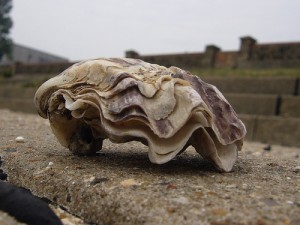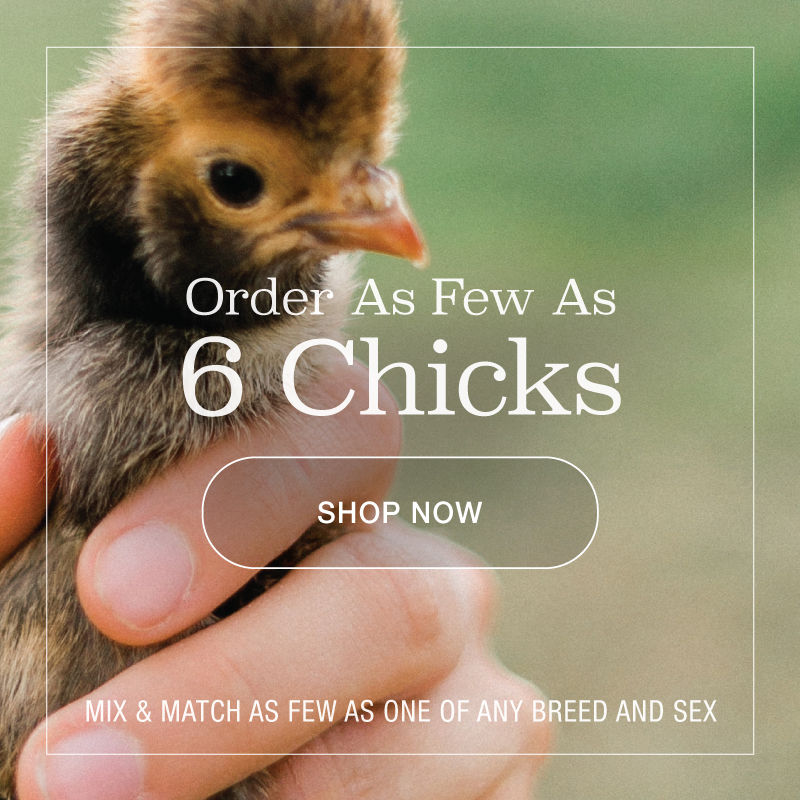If you have laying hens, we recommend that you give them ground oyster shells. It is best to do this “free choice” by putting the oyster shells in a separate container, so that the hens can take as much as they need.
The eggshell for each egg that your hen lays is about 95% calcium carbonate by dry weight. In just one year’s time, the amount of calcium that a hen will put into her eggshells can equal 20 times the amount of calcium that is contained in her bones. That’s a lot of calcium. In order to stay healthy and produce strong egg shells, she needs to consume a steady supply of calcium.
A good quality layer feed will contain enough calcium for your hens, if it is the only food they have access to. But if you let your hens forage in the yard or feed them other things, like table scraps or scratch grain in addition to commercial layer feed, they’ll need additional calcium. If your hens are laying thin shelled eggs that break easily when handled, this can indicate that they aren’t receiving enough calcium, but it isn’t a conclusive indicator because excessive phosphorous, disease, or inherited traits can also cause thin egg shells.
We only recommend feeding ground oyster shells to hens that have begun to lay eggs.
For more information about laying hen management, eggs, and egg quality, see Storey’s Guide to Raising Chickens.
[scg_html_newsletter_signup]




I work in a restaurant that goes through a lot of oysters, I was wondering if it is possible to prepare the leftover shells for my chickens and if anything special I would have to do.
Leftover oyster shells from a restaurant would work. You would just have to clean them and grind or crush them. There are a number of ways to do that, one of which is to put them into a burlap back (e.g., left over potato sack) and drive over them with your car repeatedly. You’ll have to determine for yourself whether this is worth the effort — ground oyster shells are usually inexpensive at the feed store, and the chickens don’t consume it very quickly.
I have a Barred Rock hen about 1 year old. She has been laying okay, but has been recently pecking a hole in the egg and will eat it if I don’t get to it quickly. I feed scratch and lay pellets and greens. Plenty of fresh water. I have an Americana hen too and her eggs are fine. They both seem broody. Had chickens before and did not have this problem before. Any suggestions?
My EE Rooster (4 months old) has developed a case of brownish, runny poop. All the hens (4 so far) are just fine. They are all let out of the house in the morning and are put back in the evening. Is this something I should be concerned about? Also the hen house smells. How often should we clean it? Do I need to purchase a 3 cu ft bag of pine shavings/chips every week? And how often should it be cleaned and with what?
The house is 6 feet square and 7 feet tall.
Thanks for any help.
Liz
Sorry, we are not qualified in diagnostics to determine whether the brownish, runny poop is of concern. We do carry many reference books that may be helpful for you in making your own assessment. We recommend:
Both of these books are excellent references.
Depending on the size of flock and how messy they get (determined in large part by how much time they spend in the coop), we suggest doing general cleaning every 1-2 weeks. In-between scheduled cleanings, you can add some clean shavings to mix in with the old shavings. Aerating the litter by loosening and turning it, may help control the odor.
A complete cleaning and disinfecting should be done every 1-2 years. Below are links to disinfectants that we carry:
Hey ya’ll, I am fairly new to raising chickens. I have four right now, all hens, 1 brown leghorn and three red stars. I am really interested in getting some barred rocks and/or some of the rare breeds. I am concerned about bringing new chickens into an established yard…any advise on introducing younger birds?
Shannon, we suggest putting a barrier between the two old and new groups of chickens for a while. The barrier should be something that the chickens can see through but not be able to get at each other through. You could use chicken wire, hardware cloth, plexi-glass, or something similar. The barrier will help the chickens get used to each other without being able to attach each other, so it lets them start working out their aggressions before being mixed in the same coop.
We use a dog kennel or child gate, some sort of barrier, and keep new hens in the coop for at least 3, usually 4 – 5 days before putting them in with the flock. This allows the new hens to know where “home” is, and everyone to acclimate to being new and having new flock mates.
Seems to work so far.
I’m having trouble with my red hen. For some reason she stop laying eggs. She and her sister share a rooster. I know he’s happy, but I don’t know why the two girls stopped? They are only under a year old, and I got a least a dozen eggs, two that were double yolk, but now ZIP, is there a reason? Renee in sc
Renee, please see our recent article:
9 Things to Investigate if Your Hens Aren’t Laying Well
Hi fellows, I have a couple of dozen of Guineas, and I love them. They are gorgeous birds. Well, I would like to learn how can I keep the singing loud down. Thanks for your advice.
Good luck, lol. I know that they are loud, but that’s in their nature.
I am having a problem with my chickens pecking each other. I have had to separate them until they can get their feathers back but I just had one that was very healthy that died due to a fight she had with another chicken. They have gotten along fine since birth but all of a sudden they are fighting alot. I don’t know what else to do. I would appreciate any suggestions. My feed store let me try Hot shot to spray on them so they stopped pecking each other, and that didn’t work at all. I am down to only 8 birds left.
Put about 1 tablespoon cider vinegar per gallon in their water. I have had success with this.
Try this: Wisconsin Experiment Station Bulletin #455
1 tbs salt per gallon in morning, replace with fresh
water in the afternoon.
Repeat same process in 3 days.
Provide them with things to peck and scratch at.
How much space do your girls have? If they are packed too tight or do not get to forage in the yard enough, they will peck and fight with each other more. Some fighting is expected as they establish the pecking order but, once established, it should reduce to the occasional squabble/peck.
Also, if they are not getting enough protein, they will eat each other’s feathers. Try giving them some black oil sunflower seeds (BOSS) every day to help with their protein level until the weather is warmer and they are eating more insects and worms.
I really hope this helps. Good luck.
Lill
I agree with Ms. Becker. We have had problems in the past with cannibalization. This always occurred when they were either penned up with not enough greens, when they were chicks under white light, or both. Our chickens free roam, and we have never had a pecking problem while they were loose.
Of course though, not everybody can allow their birds to roam, so if you have to keep yours penned, I would say to give them lots to peck at other than each other. Chickens love weeds, scraps, bugs, and just about anything else edible, so you could dump all the kitchen scraps into their pen, and they would probably love that. They could also be deficient in something, so you could research that too… Chickens tend to peck each other when they’re bored, so try to put interesting things in the pen (like the core from a cabbage, or the trimmings from a lettuce hanging from the roof on the end of a string).
Hope this was helpful!
Is it okay to simply dry out used egg shells and crush them and feed them back to the chickens to save a little money?
You can feed egg shells back to your hens that you have washed, dried thoroughly (important in order to prevent molds or bacteria), and thoroughly crushed. If you are using a layer feed that contains calcium, the eggshells and feed together may provide enough calcium for them. Otherwise, they may need additional calcium.
Yes, been doing that for years with my hens as well as oyster shell.
I bake the eggshells in the toaster oven to make sure that the bacteria is killed (275 for 30 min, automatic setting on our oven). The girls think the crushed shelled are a treat.
Wow, this is interesting information. I thought my chickens were getting enough of everything since they free range, are fed a high-quality layer feed and lay great hard-shelled eggs.
Are ground oyster shells the same as chicken grit? When we got our chicks, it was recommended giving them chick grit for healthy digestion. Is this correct?
There’s a difference between grit and oyster shells and the purpose of each. When chickens eat grit (or sand or small pebbles that they find naturally), it will stay in their crop, and they will use it to grind up the feed that they eat. Oyster shells, on the other hand, are soluble and will dissolve in the crop, providing the calcium that the hens need.
For baby chicks, you should start sprinkling baby chick grit onto their food the third day after you receive them. Do this similarly to how you would salt food. You don’t want to use too much, or the chicks may fill up on it. This will enable them to properly grind and digest their feed.
My girls get daily Oyster Shell, and in addition to my Extra large eggs, the shells are tough a nails. Great Stuff
I’m new to chickens. Got my first chicks last week – 50 brown egg layers. After you start giving them oyster shells, do you still need to offer them grit?
Carol, we don’t recommend feeding oyster shells to the baby chicks, but only to mature layers.
Baby chicks do need chick grit sprinkled on their food. Starting the 3rd day, sprinkle baby grit on their feed each day as if you were salting your food. Avoid putting too much at any one time as the bird may fill up on it instead of the feed.
For more information about caring for baby chicks, please visit this link:
Chick Care Tips
Let me rephrase my question. When my chickens start laying and I am offering them oyster shells, do they also need to be offered grit or do the oyster shells also serve as grit? Thanks.
Carol,
The oyster shells won’t replace the need for grit because the oyster shells are soluble and will dissolve in their crop, so they won’t perform the same function as the grit. That being said, if you let your chickens out regularly or give them access to soil, then normally you won’t have to supply any additional grit because they will get all the grit they need from pebbles and sand that they find naturally.
This is my first time raising chickens; I quilt and have ALOT of cotton scraps; could they be cut up small and used for bedding ?
You will have to be careful, if they eat little (or bigger) pieces they may get stuck in the crop and cause problems. I wouldn’t do it. You would be surprised what a chicken will put in their mouth! Straw is best, or wood shavings of a size they cant eat, or too small to be a problem if they do. Chicks will eat wood shavings, never use them for chicks.
Thanks for this! I actually didn’t know that layer feed had that much calcium in it. I had thought you had to always make sure they had free choice scratch and oyster shell, I learned that from my dad years back and never thought more of it but I’m glad he taught me well.
Thanks for the clarification. I was told that lay pellets provide enough calcium, but I was having a high rate of thin shelled eggs. I allow my chickens to free range several days a week. Through trial and error I have found that 40lbs of oyster shell in a separate pan lasts for three months. I have over one hundred chickens. Right now I have two hens that lay thin shelled eggs, so I’m marking it up to genetics.